Bathroom safety should never be compromised for style. With over 235,000 bathroom-related injuries occurring annually in the United States, choosing the right slip-resistant flooring is crucial for creating a safe, functional, and beautiful bathroom space. This comprehensive guide explores the best non-slip flooring options, safety ratings, installation considerations, and design ideas to help you make informed decisions for your bathroom renovation.
Content
- 1 Understanding Bathroom Floor Safety Requirements
- 2 Top Slip-Resistant Flooring Materials for Bathrooms
- 3 Specialized Safety Flooring for High-Risk Areas
- 4 Design Ideas for Slip-Resistant Bathroom Floors
- 5 Installation Best Practices for Maximum Safety
- 6 Maintenance and Long-Term Performance
- 7 Budget Considerations and Cost Analysis
- 8 Special Considerations for Different Bathroom Types
- 9 Future Trends in Bathroom Safety Flooring
- 10 FAQ
- 10.1 What is the safest flooring for a bathroom?
- 10.2 How do I know if my bathroom floor is slip-resistant enough?
- 10.3 Can I make my existing bathroom floor more slip-resistant?
- 10.4 What's the best flooring for walk-in showers?
- 10.5 How much does slip-resistant bathroom flooring cost?
- 10.6 Is professional installation necessary for bathroom flooring?
- 11 Transform Your Bathroom with Safe, Beautiful Flooring
- 12 Our Professional Services
Understanding Bathroom Floor Safety Requirements
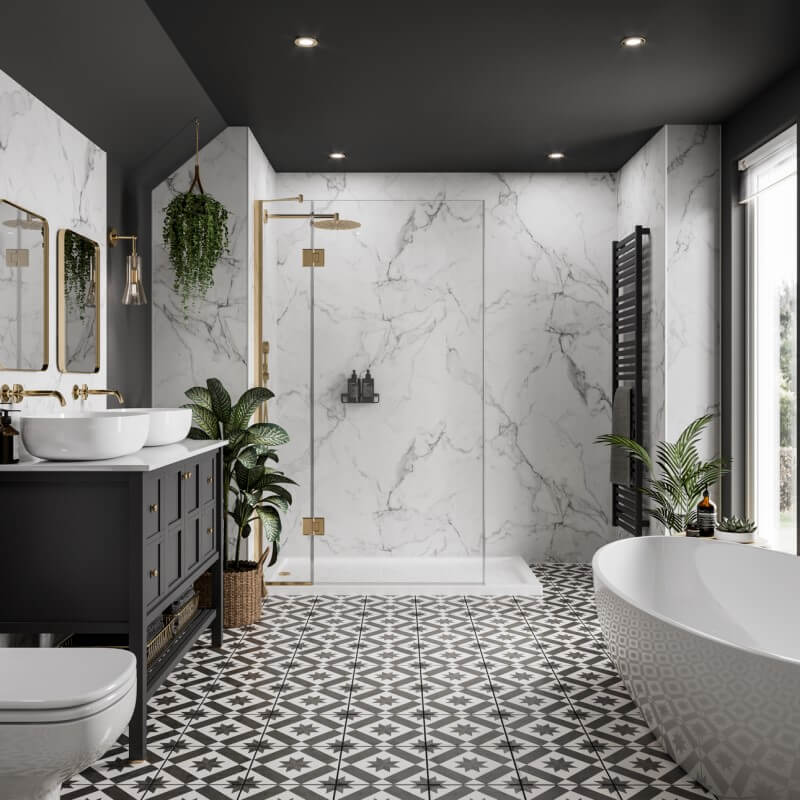
Before diving into specific flooring options, it’s essential to understand what makes bathroom flooring truly slip-resistant and safe for wet conditions.
The Science Behind Slip Resistance
Slip resistance is measured using the Coefficient of Friction (COF), which indicates how much traction a surface provides. For bathroom applications, the Americans with Disabilities Act (ADA) recommends a minimum COF of 0.6 for level surfaces and 0.8 for ramps. However, many safety experts recommend even higher ratings for wet bathroom environments.
The Dynamic Coefficient of Friction (DCOF) specifically measures slip resistance on wet surfaces, making it the most relevant measurement for bathroom flooring. Look for tiles and flooring materials with a DCOF rating of 0.42 or higher for optimal bathroom safety.
Factors Affecting Bathroom Floor Safety
Several factors beyond the flooring material itself impact bathroom safety:
Surface Texture: Textured surfaces provide better grip than smooth finishes, especially when wet. However, excessive texture can make cleaning difficult and harbor bacteria.
Water Drainage: Proper floor slope and drainage prevent water accumulation, reducing slip hazards regardless of flooring type.
Grout Lines: The width, depth, and texture of grout lines significantly impact overall floor traction. Wider grout lines with textured grout can improve slip resistance.
Maintenance Requirements: Some flooring materials require specific cleaning products or techniques to maintain their slip-resistant properties over time.
Top Slip-Resistant Flooring Materials for Bathrooms
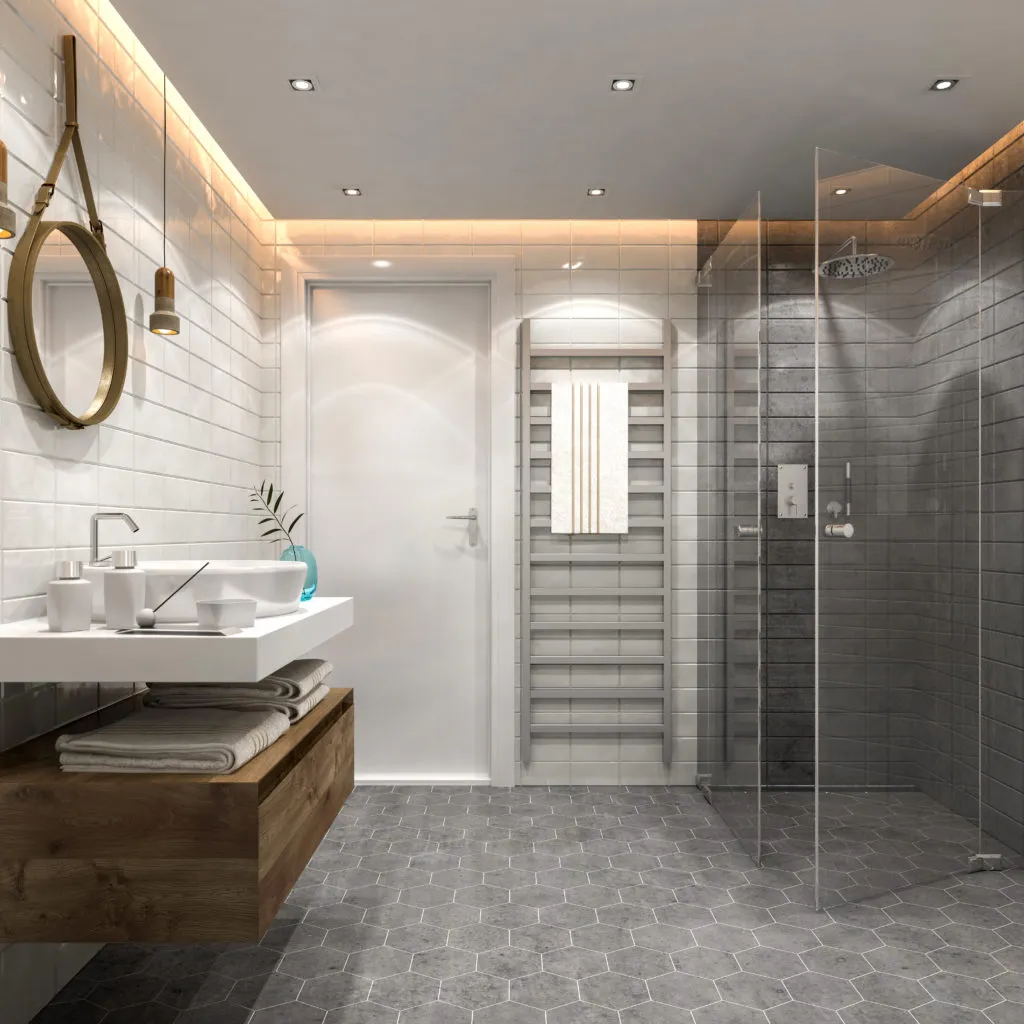
Textured Ceramic and Porcelain Tiles
Ceramic and porcelain tiles remain the most popular choice for bathroom floors due to their durability, water resistance, and variety of slip-resistant options.
Advantages of Textured Ceramic Tiles:
- Excellent water resistance when properly installed
- Wide range of textures and finishes available
- Durable and long-lasting with proper maintenance
- Cost-effective compared to natural stone options
- Easy to clean with appropriate techniques
Best Textured Tile Options:
- Matte finish tiles provide natural slip resistance without excessive texture
- Raised pattern tiles offer enhanced grip while maintaining cleanability
- Stone-look porcelain combines natural stone aesthetics with superior slip resistance
- Penny tiles create natural texture through numerous grout lines
Installation Considerations: Choose tiles with a DCOF rating of 0.42 or higher for wet areas. Consider smaller tile sizes (2×2 or 4×4 inches) to increase grout line frequency, which naturally improves traction. Use high-quality, textured grout to enhance overall slip resistance.
Natural Stone with Anti-Slip Treatments
Natural stone flooring can provide excellent slip resistance when properly selected and treated, offering timeless beauty alongside safety features.
Best Natural Stone Options:
- Honed travertine offers natural texture and excellent slip resistance
- Tumbled marble provides grip through its naturally textured surface
- Slate flooring delivers superior traction with its naturally rough texture
- Sandstone tiles offer excellent grip and water absorption properties
Treatment Options:
- Anti-slip coatings can be applied to increase traction on smooth stone surfaces
- Flamed finishes create texture on granite and other hard stones
- Brushed finishes provide subtle texture without compromising the stone’s natural beauty
Maintenance Requirements: Natural stone requires regular sealing to maintain water resistance and prevent staining. Some stones may need specialized cleaning products to preserve their slip-resistant properties.
Luxury Vinyl Flooring for Bathrooms
Modern luxury vinyl flooring offers excellent slip resistance, water resistance, and comfort underfoot, making it an increasingly popular choice for bathroom applications.
Waterproof Vinyl Advantages:
- 100% waterproof construction prevents water damage
- Comfortable underfoot, reducing fatigue during long grooming sessions
- Easy installation, often suitable for DIY projects
- Cost-effective alternative to natural materials
- Excellent slip resistance when properly textured
Best Vinyl Options for Bathrooms:
- Luxury Vinyl Plank (LVP) with textured surfaces mimics wood while providing safety
- Luxury Vinyl Tile (LVT) offers stone and ceramic looks with superior grip
- Sheet vinyl provides seamless installation with fewer joints for water infiltration
Installation Tips: Ensure proper subfloor preparation and use appropriate adhesives for wet areas. Pay special attention to seams and edges to prevent water infiltration. Consider professional installation for best results in high-moisture environments.
Rubber Flooring Solutions
Rubber flooring provides exceptional slip resistance and comfort, making it an excellent choice for bathrooms, especially those designed for seniors or individuals with mobility challenges.
Benefits of Rubber Bathroom Flooring:
- Superior slip resistance, even when wet
- Comfortable and cushioned underfoot
- Naturally antimicrobial properties in many formulations
- Easy to clean and maintain
- Available in various colors and patterns
Types of Rubber Flooring:
- Rubber tiles offer easy installation and replacement options
- Sheet rubber provides seamless coverage with minimal joints
- Textured rubber enhances grip while maintaining comfort
Considerations: While rubber flooring excels in safety and comfort, it may not suit all design aesthetics. Modern rubber flooring options offer improved appearance and can complement contemporary bathroom designs.
Specialized Safety Flooring for High-Risk Areas
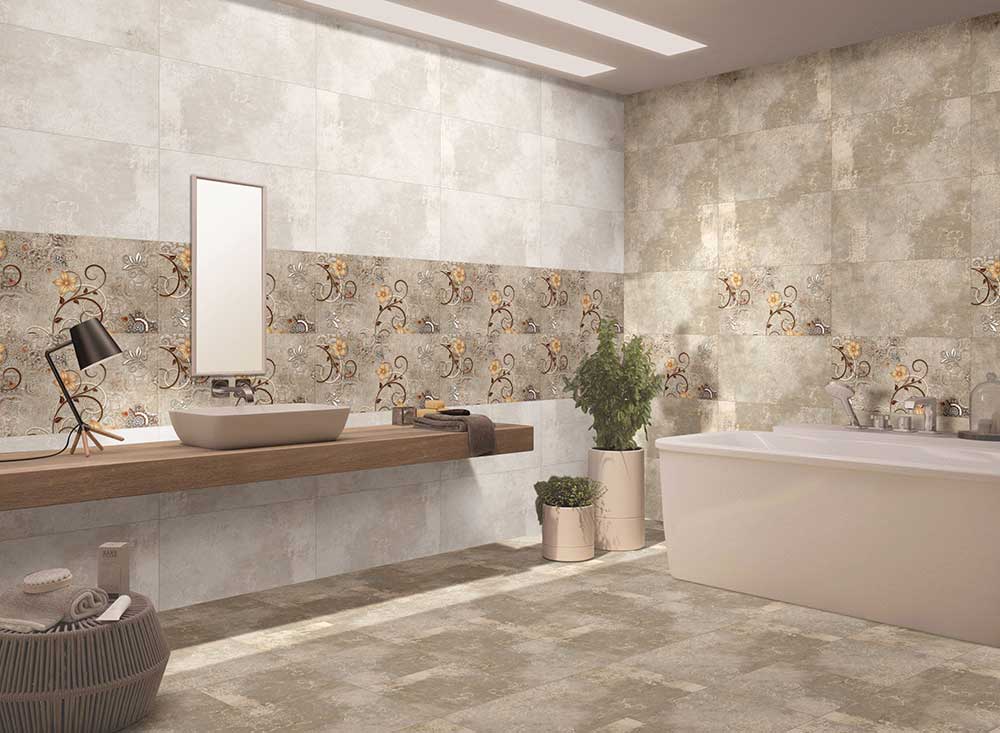
Walk-in Shower Flooring Options
Walk-in showers require the highest level of slip resistance due to constant water exposure and soap residue.
Best Shower Floor Materials:
- Small mosaic tiles (1×1 inch or smaller) maximize grout lines for enhanced traction
- Pebble tiles provide natural texture and excellent drainage
- Textured porcelain specifically designed for shower applications
- Natural stone with anti-slip treatments for luxury shower installations
Shower Floor Design Considerations:
- Ensure proper slope (1/4 inch per foot minimum) toward drains
- Use appropriate waterproofing membranes behind all tile installations
- Consider linear drains for better water management and safety
- Install grab bars and other safety features as needed
Safe Bathroom Flooring for Seniors
Aging-in-place bathroom designs require special attention to slip resistance and accessibility features.
Senior-Friendly Flooring Features:
- High slip resistance ratings (DCOF 0.6 or higher)
- Comfortable underfoot to reduce joint stress
- Easy to clean and maintain
- Compatible with mobility aids like walkers and wheelchairs
- Good contrast with walls and fixtures for visual clarity
Recommended Materials:
- Textured vinyl flooring provides comfort and safety
- Rubber flooring offers maximum slip resistance and cushioning
- Small ceramic tiles with textured grout for enhanced traction
- Cork flooring (properly sealed) provides natural antimicrobial properties and comfort
ADA Compliant Flooring Solutions
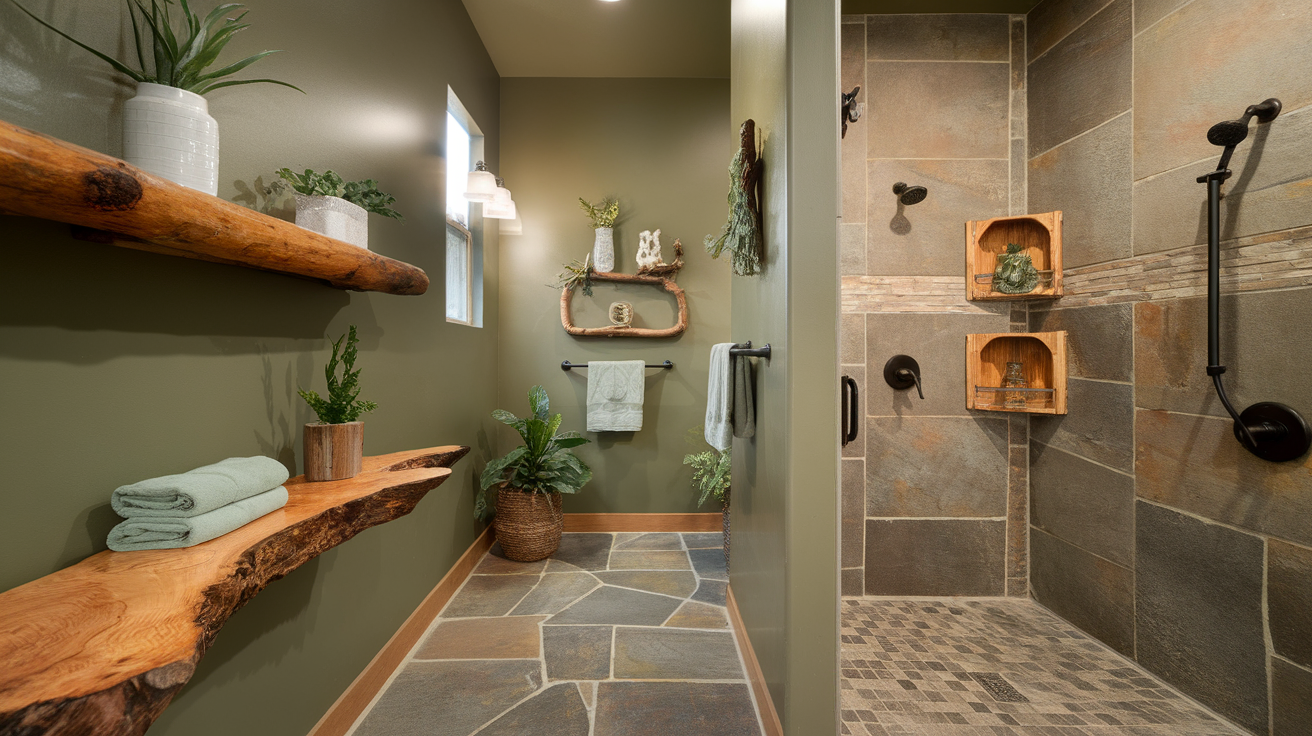
Bathrooms designed for accessibility must meet specific ADA requirements for flooring safety and functionality.
ADA Flooring Requirements:
- Minimum DCOF rating of 0.6 for level surfaces
- Maximum 1/2 inch vertical changes in floor level
- Beveled transitions between different flooring materials
- Slip-resistant surfaces throughout the bathroom space
Compliant Flooring Options:
- Commercial-grade vinyl with appropriate slip ratings
- Textured ceramic tiles meeting ADA specifications
- Rubber flooring with proper installation techniques
- Sealed concrete with anti-slip additives
Design Ideas for Slip-Resistant Bathroom Floors
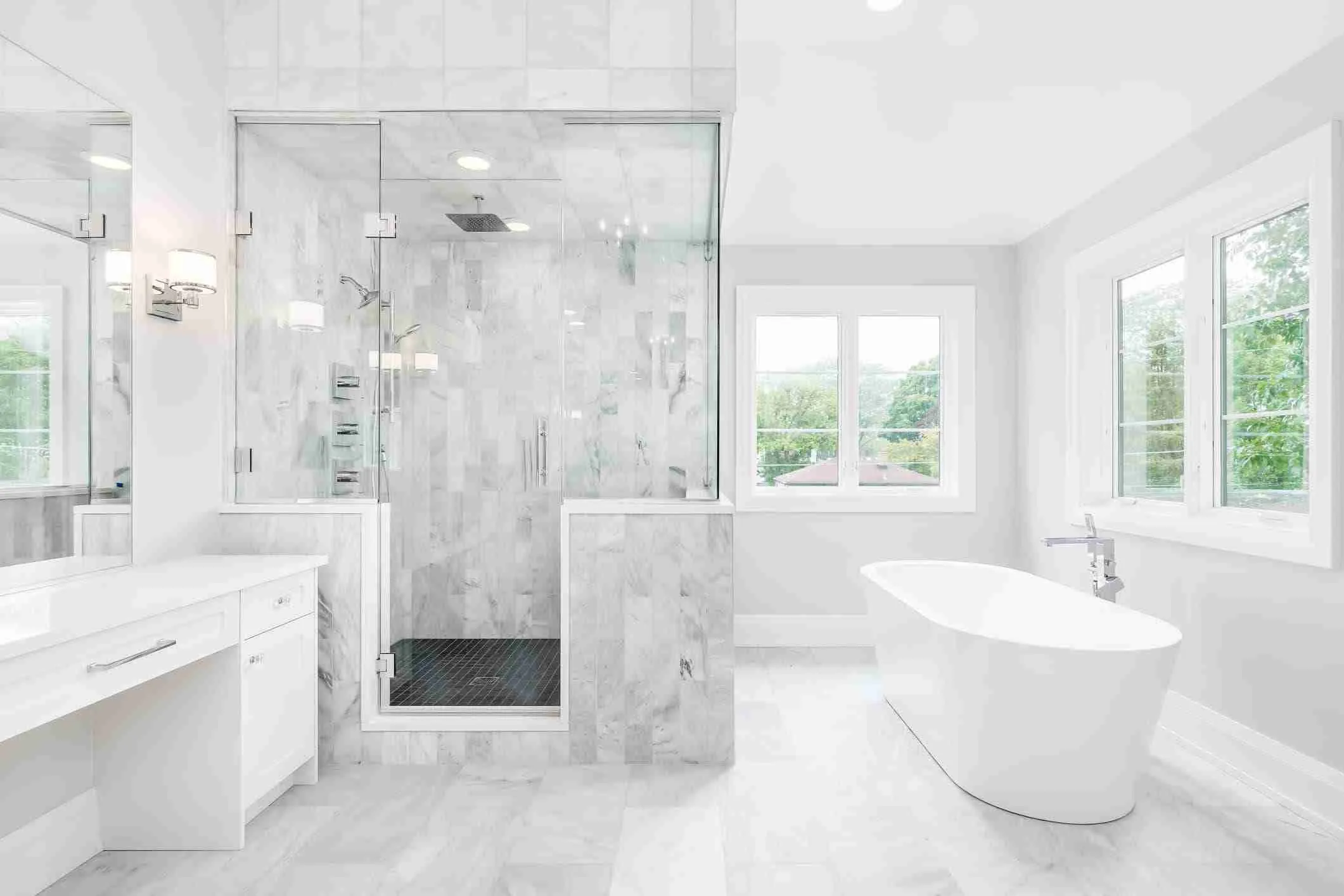
Combining Safety with Style
Modern slip-resistant flooring options don’t require sacrificing aesthetics for safety. Contemporary designs successfully integrate both elements.
Design Strategies:
- Mixed materials combine slip-resistant areas with decorative elements in dry zones
- Pattern play uses different tile sizes and layouts to enhance both safety and visual interest
- Color coordination ensures slip-resistant materials complement overall bathroom design
- Texture variation creates visual depth while maintaining safety standards
Popular Design Trends
2025 Bathroom Flooring Trends:
- Large format tiles with subtle texture for modern aesthetics
- Wood-look vinyl providing warmth and safety in wet areas
- Geometric patterns using small tiles for enhanced traction
- Natural stone looks in porcelain for durability and slip resistance
Color and Pattern Considerations
Safety Through Design:
- High contrast between flooring and fixtures improves visibility
- Subtle patterns can hide water spots while maintaining slip resistance
- Neutral colors provide timeless appeal and easy coordination with changing decor
- Darker grout shows less dirt and soap residue over time
Installation Best Practices for Maximum Safety

Professional vs. DIY Installation
While some slip-resistant flooring options are suitable for DIY installation, bathroom applications often benefit from professional expertise.
When to Choose Professional Installation:
- Natural stone flooring requiring specialized techniques
- Complex waterproofing requirements
- ADA compliance needs
- Structural modifications for proper drainage
DIY-Friendly Options:
- Luxury vinyl flooring with click-lock systems
- Rubber tiles with adhesive backing
- Some ceramic tile installations for experienced DIYers
Critical Installation Details
Waterproofing Requirements: Proper waterproofing is essential for any bathroom flooring installation. Use appropriate membranes, sealers, and installation techniques to prevent water damage and maintain slip resistance over time.
Grout Selection and Application: Choose grout with appropriate texture and color for your specific application. Epoxy grouts offer superior stain resistance and durability in wet environments.
Transition Management: Plan transitions between different flooring materials carefully to maintain safety and accessibility standards throughout the bathroom space.
Maintenance and Long-Term Performance

Cleaning Slip-Resistant Flooring
Different flooring materials require specific cleaning approaches to maintain their slip-resistant properties.
General Cleaning Guidelines:
- Use pH-neutral cleaners appropriate for your specific flooring material
- Avoid harsh chemicals that can damage slip-resistant surfaces
- Regular cleaning prevents soap scum and mineral buildup that can create slip hazards
- Address spills and standing water immediately
Material-Specific Maintenance:
- Ceramic and porcelain tiles: Regular grout cleaning and periodic sealing
- Natural stone: Appropriate sealing schedule and stone-specific cleaners
- Vinyl flooring: Simple cleaning with manufacturer-recommended products
- Rubber flooring: Regular cleaning with mild detergents and periodic deep cleaning
Preserving Slip Resistance Over Time
Long-term Maintenance Strategies:
- Regular inspection for wear patterns or damage
- Prompt repair of damaged areas to maintain safety
- Periodic professional cleaning for optimal performance
- Replacement of worn areas before they become safety hazards
Signs of Wear and When to Replace
Warning Signs:
- Visible wear patterns in high-traffic areas
- Reduced slip resistance when wet
- Cracked or damaged grout lines
- Loose or damaged tiles or flooring sections
Budget Considerations and Cost Analysis
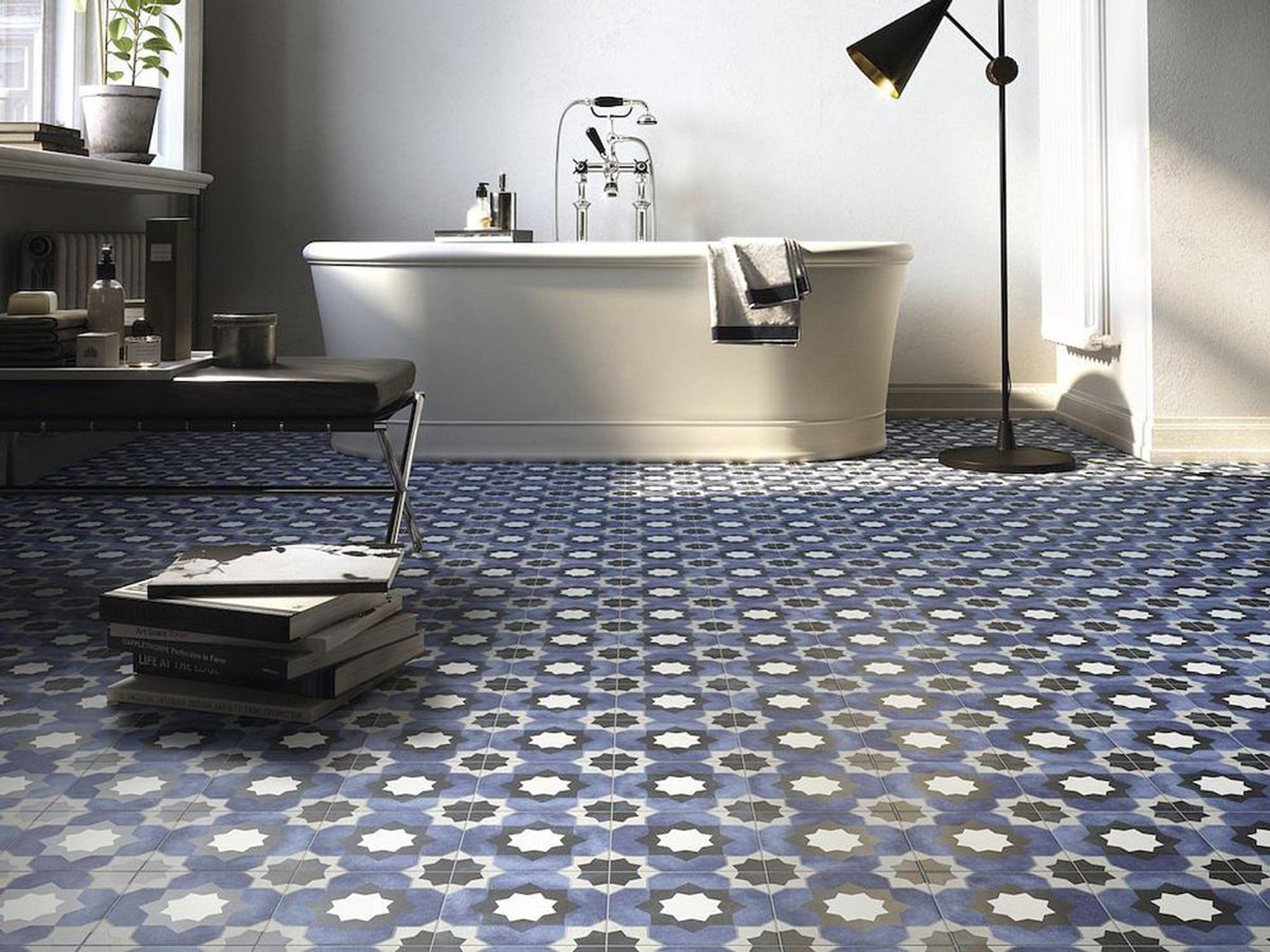
Cost Comparison of Slip-Resistant Options
Understanding the total cost of ownership helps make informed flooring decisions for bathroom renovations.
Budget-Friendly Options:
- Textured ceramic tiles: $2-8 per square foot installed
- Vinyl flooring: $3-10 per square foot installed
- Basic rubber tiles: $4-12 per square foot installed
Mid-Range Choices:
- Porcelain tiles: $5-15 per square foot installed
- Luxury vinyl: $6-18 per square foot installed
- Treated natural stone: $8-25 per square foot installed
Premium Selections:
- High-end porcelain: $10-30 per square foot installed
- Natural stone with treatments: $15-50 per square foot installed
- Commercial-grade rubber: $12-35 per square foot installed
Value Engineering for Bathroom Safety
Maximizing Safety Within Budget:
- Focus slip-resistant materials in highest-risk areas
- Use budget-friendly options in dry zones
- Consider long-term maintenance costs in decision-making
- Invest in professional installation for critical areas
Special Considerations for Different Bathroom Types
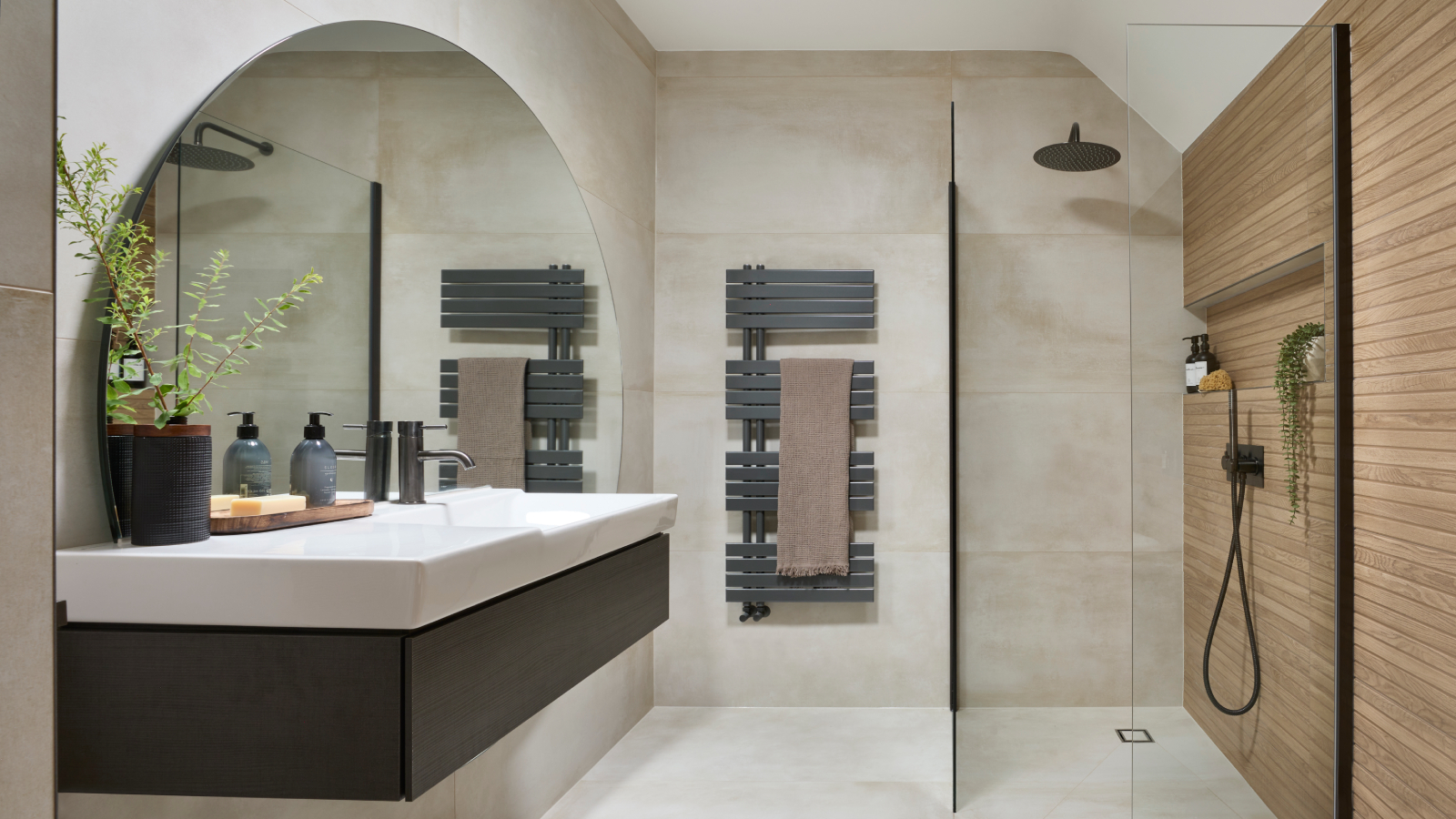
Master Bathroom Suites
Large master bathrooms allow for zoned flooring approaches, using different materials for different areas while maintaining overall design cohesion.
Zoning Strategies:
- Wet zones: Maximum slip resistance near tubs and showers
- Dry zones: Decorative materials with moderate slip resistance
- Transition areas: Careful material selection for smooth transitions
Small Bathroom Optimization
Limited space requires careful material selection to maximize both safety and visual appeal.
Small Bathroom Tips:
- Light colors and large tiles can make spaces appear larger
- Consistent flooring throughout creates visual continuity
- Strategic texture placement enhances safety without overwhelming the space
Guest Bathroom Considerations
Guest bathrooms need to accommodate users unfamiliar with the space while maintaining design appeal.
Guest Bathroom Priorities:
- Clear visual cues for safety features
- Universal design principles for broad usability
- Easy maintenance for consistent performance
Future Trends in Bathroom Safety Flooring
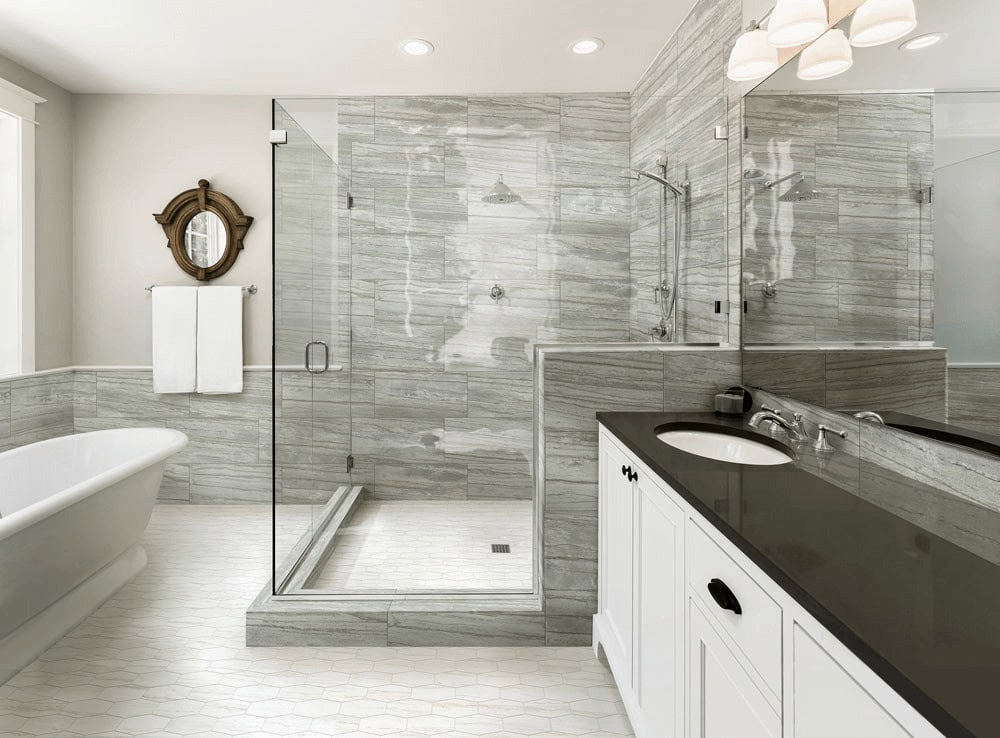
Emerging Technologies
New technologies continue to improve bathroom flooring safety and performance.
Innovation Areas:
- Smart surfaces that change texture based on moisture levels
- Antimicrobial treatments integrated into flooring materials
- Improved slip coatings with longer-lasting performance
- Sustainable materials with enhanced safety features
Sustainable Safety Options
Environmental consciousness drives development of eco-friendly slip-resistant flooring options.
Green Flooring Trends:
- Recycled content materials with safety certifications
- Low-VOC options for improved indoor air quality
- Renewable materials like cork and bamboo with slip-resistant treatments
- Long-lasting materials that reduce replacement frequency
FAQ
How do I know if my bathroom floor is slip-resistant enough?
Check the manufacturer's specifications for DCOF (Dynamic Coefficient of Friction) ratings. For bathroom applications, look for ratings of 0.42 or higher, with 0.6 being preferred for areas used by seniors or individuals with mobility challenges. If your current flooring feels slippery when wet or lacks texture, it may not provide adequate slip resistance.
Can I make my existing bathroom floor more slip-resistant?
Yes, several options exist for improving existing floor safety. Anti-slip treatments can be applied to ceramic, porcelain, and natural stone surfaces. Anti-slip strips or mats can provide temporary solutions, though permanent treatments or replacement offer better long-term results. Professional assessment can determine the best approach for your specific flooring type.
What's the best flooring for walk-in showers?
Walk-in showers require maximum slip resistance due to constant water exposure. Small mosaic tiles (1x1 inch or smaller) provide excellent traction through numerous grout lines. Pebble tiles offer natural texture and good drainage. Textured porcelain specifically designed for shower use also performs well. Ensure proper slope and drainage regardless of material choice.
How much does slip-resistant bathroom flooring cost?
Costs vary significantly based on material choice and installation complexity. Budget options like textured ceramic tiles range from $2-8 per square foot installed. Mid-range choices including porcelain and luxury vinyl cost $5-18 per square foot installed. Premium options like treated natural stone can cost $15-50 per square foot installed. Consider long-term maintenance costs when budgeting.
Is professional installation necessary for bathroom flooring?
While some materials like luxury vinyl tiles can be DIY-friendly, bathroom installations often benefit from professional expertise due to waterproofing requirements, proper drainage needs, and safety considerations. Professional installation is recommended for natural stone, complex tile patterns, ADA-compliant installations, and any project requiring structural modifications.
Transform Your Bathroom with Safe, Beautiful Flooring
Choosing the right slip-resistant flooring for your bathroom doesn’t mean compromising on style or breaking your budget. By understanding safety requirements, exploring material options, and considering long-term maintenance needs, you can create a bathroom that’s both beautiful and safe for all users.
Whether you’re planning a complete bathroom renovation or simply upgrading your flooring for better safety, the key is selecting materials and installation methods that provide lasting performance and peace of mind. From budget-friendly ceramic options to luxury natural stone with anti-slip treatments, today’s flooring market offers solutions for every style preference and safety requirement.
Ready to upgrade your bathroom flooring for better safety and style? Our flooring experts at SafeFloor Solutions specialize in slip-resistant bathroom installations that combine safety with stunning aesthetics. Contact us today for a free consultation and discover how professional guidance can help you create the perfect balance of safety, functionality, and beauty in your bathroom space.
Our Professional Services
Slip-Resistant Flooring Installation
Transform your bathroom with professionally installed slip-resistant flooring that meets the highest safety standards. Our certified installers specialize in wet area applications and ensure proper waterproofing and drainage for lasting performance.
Bathroom Safety Assessments
Our safety experts evaluate existing bathroom conditions and recommend improvements to reduce slip and fall risks. We provide detailed reports with prioritized recommendations and cost estimates for maximum safety enhancement.
Custom Bathroom Design & Renovation
Create beautiful, safe bathrooms with our comprehensive design and renovation services. We specialize in aging-in-place modifications, ADA-compliant installations, and luxury bathroom transformations that prioritize both safety and style.
Flooring Material Consultation
Navigate the complex world of bathroom flooring options with expert guidance. Our consultants help you select the perfect materials based on your specific needs, budget, and design preferences while ensuring optimal safety performance.
Maintenance and Restoration Services
Keep your slip-resistant flooring performing at its best with our professional maintenance and restoration services. We provide cleaning, sealing, repair, and refinishing services to extend the life and safety of your bathroom flooring investment.
Contact SafeFloor Solutions today or visit our showroom at 456 Safety Street to explore our extensive collection of slip-resistant bathroom flooring options. Our expert team is ready to help you create a safer, more beautiful bathroom space.


